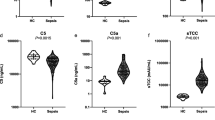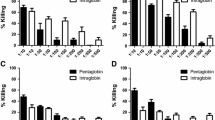Summary
In order to explain complement components abnormalities observed during septic shock, circulating immune complexes (C.I.C.) were searched for in sera from 34 patients with gram negative sepsis by two different methods: polyethylene glycol precipitation test based on physical properties of C.I.C. and C1q deviation test based on the property of radiolabelled C1q to react with C.I.C. Serum immunoglobulins (IgG, IgA, IgM) and complement components (C1q, C3, C4) levels were simultaneously determined. Seventeen patients with minimal haemodynamic abnormalities had normal or increased levels (except C4 at 62% of normal) and in eleven cases both tests for C.I.C. were simultaneously positive. Seventeen patients with severe septic shock had a decrease in IgG, IgM, C1q, C3 and C4 and none had both tests for C.I.C. simultaneously positive (P<10−4). The disappearence of C.I.C. in patients with severe septic shock associated with evidence of complement activation suggests their involvement in the pathogenesis of septic shock in man.
Similar content being viewed by others
References
Winslow EJ, Loeb MS, Rahintoola SH, Kamath S, Gunnar RH (1973) Haemodynamic studies and results of therapy in 50 patients with bacteriema shock. Am J Med 54:421
Regnier B, Rapin M, Gory O, Lemaire F, Teisseire B, Harari A (1977) Haemodynamic effects of dopamine in septic shock. Interes Med 3:47, 53
McCabe WR, Kreger BE, Johns M (1972) Type-specific and cross-reactive antibodies in gram-negative bactereamia. N Engl J Med 287:261
Kayser B, Olling S (1973) Experimental hematogenous pyelonephritis due to Escherichia Coli in rabbits: the antibody response and its protective capacity. J Infect Dis 128:41
Zinner SH, McCabe WR (1976) Effect of IgM and IgG antibody in patients with bacteremia due to gram-negative bacilli. J Infect Dis 133:37
George C, Robin M, Carlet J, Rapin M, Landais C, Sabatier C (1978) Tests cutanés explorant l'immunité cellulaire chez les malades en réanimation. Relation entre les résultats et la mortalité. Nouv Presse Med 7:2541
MacLean LD, Meakins JL, Tagucki K, Ovignan JP, Omillon KS, Gordon J (1975) Host resistance in sepsis and trauma. Ann Surg 182:207
Meakins JL, Pietsch JB, Budenick O, Kelly R, Rode H, Gordon J, MacLean LD (1977) Delayed hypersensitivity: Indication of acquired failure of host defenses in sepsis and trauma. Ann Surg 186:241
Bokish VA, Top FH, Russel PK, Dixon FJ, Muller-Eberhard HJ (1973) The potential pathogenic role of complement in Dengue hemorrhagic shock syndrome. N Engl J Med 289:996
McCabe WR (1973) Serum complement levels in bacteremia due to gram-negative organisms. N Engl J Med 288:21
Robin M, Intrator L, Andre C, Lagrue G, Rapin M (1974) Anomalies du complement et choc infectieux. Nouv Presse Méd 3:883–884
Robinson JA, Klodnycky ML, Loeb HS, Racic MR, Gunnar RM (1975) Endotoxin, Prekallikrein, Complement, Vascular Resistances. Sequential measurements in man. Am J Med 59:61
Fearon DT, Ruddy S, Schur PH, McCabe WR (1975) Activation of the properdin pathway of complement in patients with gram-negative bacteremia. N Engl J Med 292:937
Robin M, Intrator L, Rapin M (1975) Complement activation in septic shock. N Engl J Med 293:1261
Fust G, Petras G, Ujhelyi E (1976) Activation of the complement system during infections due to gram-negative bacteria. Clin Immunol 5:293
Mancini G, Carbonara AO, Heremans JF (1965) Immunochemical quantitation of antigens by single radial immunodiffusion. Immunochemistry 2:235
Sobel AT, Bokisch VA, Muller-Eberhard HJ (1975) C1q deviation test for the detection of immune complexes, aggregates of IgG, and bacterial products in human serum. J Exp Med 142:139
Creighton DW, Lambert PH, Miescher P (1973) Detection of antibodies and soluble antigen-antibody complexes by precipitation with polyethylen-glycol. J Immunol 111:1219
Schur PH (1978) Immune complex assays: the state of the art. N Engl J Med 298:161
Herreman G, Godeau P, Cabane J, Digeon M, Laver M, Bach JF (1975) Etude immunologique des endocardites infectieuses subaiguës par recherche de complexes immuns circulants. Résultats préliminaires à propos de 13 observations. Nouv Presse Méd 4:2311
Bayer AS, Theofilopoulos AN, Eisenberg R, Dixon FJ, Guze LB (1976) Circulating immune complexe in infective endocarditis. N Engl J Med 295:1500
Elin RJ, Robinson RA, Levine AS, Wolff SM (1975) Lack of clinical usefulness of the limulus test in the diagnosis of endotoxemia. N Engl J Med 293:521
Nydegger U, Kazatchkine M, (1979) La détection des complexes immuns solubles. Nouv Presse Méd 8:203
Dupuy C, Dupuy JM (1977) Complement studies in severe viral hepatic of childhood. Pathol Biol 25:553
Muller-Eberhard HJ (1976) The serum complement system in “text book of immunopathology”. Miescher PA, Muller-Eberhard MJ (eds). Grune and Stratton, New York, p 45
Sobel AT, Cooper NR, Schreiber RD (1979) Activation of the classical pathway by nephritic factor bound to the alternative pathway C3/C5 convertase. J Immunol 123:34–38
Bjornson AB, Altemeier WA, Bjornson MS (1978) Host defenses against opportunist micro organisms following trauma. II. Change in complement and immunoglobulins in patients with abdominal trauma and septic patients without trauma. Ann Surg 188:102
Jacob HS (1978) Granulocyte complement interaction. A beneficial antimicrobial mechanism that can cause disease. Arch Intern Med 138:461
Bayer AS, Theofilopoulos AN, Tillman DB, Dixon FJ, Guze LG (1979) Use of circulating immune complex levels in the sero-diffeentiation of endocarditic and non endocarditic septicemias. Am J Med 66:58
Author information
Authors and Affiliations
Additional information
This work was supported by grants from “Conseil Scientifique de l'Université Paris Val de Marne” and “Délégation Générale de la Recherche Scientifique et Technique”, Contracts N° 7510954 and 7771396
Rights and permissions
About this article
Cite this article
George, C., Carlet, J., Sobel, A. et al. Circulating immune complexes in patients with gram negative septic shock. Intensive Care Med 6, 123–127 (1980). https://doi.org/10.1007/BF01683357
Issue Date:
DOI: https://doi.org/10.1007/BF01683357




